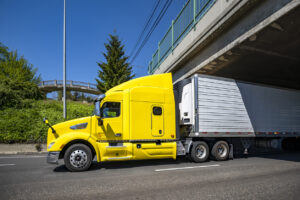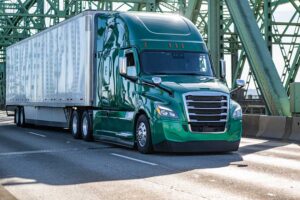Making business decisions is hard. It’s even harder when the direction of the economy is unclear.
“We’re kind of in this fog of war. Everybody’s making very short-term decisions right now,” said Jonathan Starks, CEO of FTR Transportation Intelligence.
This statement, made during a May 9 “State of Freight” webinar, refers to trade wars, disputes between countries over imports and exports, and fees charged by each to “equalize” the markets.
The issue is tariffs.
Since taking office in January, President Donald Trump has announced massive tariffs against a number of U.S. trade partners. However, he has also suspended, delayed, reduced or made exceptions for those tariffs almost as quickly as he announced them.
Trump’s announced goals — to create a fairer marketplace for American exports to other countries and to revive manufacturing in the U.S. — can be achievable over time. In the short term, however, decision makers at U.S. carriers want to see how it all shakes out before making long term commitments.
According to Avery Vise, FTR’s vice president of trucking, economic forecasters have changed their projections based on tariffs. In 2024, he says, global tariffs averaged 2%; in 2025 they’ve skyrocketed to 21%.
“This is a very large increase, and one of the effects of that is that we believe core inflation will rise,” he said.
However, not all increases will be felt by consumers because many companies absorb a portion of the tariff cost, Vise says. He also points out that core inflation does not include energy and food and notes that energy prices have moderated recently.
Inflation is also top of mind at the Federal Reserve.
After cutting its Federal Funds Effective Rate by a full percentage point in 2024, the Fed announced following a May 6, 2025, meeting that the rate would remain unchanged at 4.3%, the third time in a row it has done so.
Speaking after the meeting, Fed Chairman Jerome Powell blamed tariffs for market uncertainty.
“If the large increases in tariffs that have been announced are sustained, they’re likely to generate a rise in inflation, a slowdown in economic growth and a rise in unemployment,” he predicted.
Tariffs impact the U.S. economy.
Tariffs, or at least the threat of them, have already impacted the nation’s economy. The U.S. Census Bureau reported a substantial increase in total imports for the year to date.
Importers, concerned about future tariffs, are stocking up before tariffs take effect.
More containers arriving at U.S. seaports may temporarily mean more freight for truckers — but it can’t last.
Talks continue between the U.S. and other nations.
The largest announced tariffs so far are on freight from China at a rate of 125%. Following Trump’s April 8 announcement, China quickly imposed retaliatory tariffs.
The Trump administration has claimed that China unfairly profits from selling in the U.S. market while closing its markets to most U.S. products.
On May 12 however, following talks between the U.S. and China addressing tariffs and other trade barriers, officials from both nations announced a 90-day pause while discussions continue.
The U.S. has already announced progress on trade deals with Inda and Great Britain as well as meetings with Japan, Italy and the European Union. Promising “90 deals in 90 days,” the administration claimed that as many as 15 offers have been made to other countries with more to come.
It’s a case of ‘deal or no deal.’
When deals are made, trade increases and both countries benefit. When deals aren’t made, trade partners impose tariffs, making it more difficult for other countries to reach their markets.
When this happens, those markets look elsewhere for needed products. Often, “elsewhere” is in their own back yard, increasing domestic production to meet consumer needs.
In the long term, that’s a positive — except that manufacturers may have stopped producing certain items in the first place because it was cheaper to import them. Restarting manufacturing centers or building new ones adds to production costs.
Impending tariffs have spurred car-buying.
New cars and light-duty trucks are a good example of what happens when trade wars loom.
U.S. vehicle manufacturers have plants in both Canada and Mexico, where some models are assembled for sale in the U.S. and parts are manufactured for final assembly elsewhere.
Trump’s announced tariffs have motivated buyers to get purchase before tariffs go into effect: Sales of new cars and light-duty trucks have risen to levels not seen since 2021, according to the U.S. Bureau of Economic Analysis.
There’s a caveat, however. Those buyers aren’t buying MORE; they’re simply buying EARLIER in an effort to get ahead of pending tariffs. As tariffs are imposed, sales will decline as consumer prices rise.
Unemployment rates will rise as auto workers are laid off, and the economy will take a hit. Other countries that impose retaliatory tariffs will cause fewer U.S. built cars to be sold in their countries, depressing the market even further.
In the next phase, however, some vehicle manufacturers will move production to the U.S. to avoid tariffs. Three foreign-owned automakers — Hyundai, Mercedes and Honda — have already pledged to do so.
In the long term, building vehicles in the U.S. will provide jobs for Americans, stimulating the economy. No matter where cars and trucks are built, sooner or later they wear out and consumers replace them.
Tariffs have an impact on the GDP.
During FTR’s May 9 webinar, Bill Witte, chief forecaster at Witte Economics, discussed the impact of tariffs on the U.S. Gross Domestic Product.
“Tariffs are a negative supply shock to the economy, and a positive for prices,” he said.
Witte predicts an increase in the inflation rate and a corresponding increase in unemployment. He cites market uncertainty as a negative force.
“Uncertainty right now is really off the charts,” he said. “If you don’t know what’s going to happen, you can’t really make rational decisions.”
Witt compared the current economy with the one we experienced during and just after the COVID-19 pandemic, noting that “supply chains will be disrupted.” He points out that over time, supply chains become very efficient.
“By having to having to switch (those supply chains) for a sort of artificial reason — a tariff reason — the result will be something that is less efficient,” he said, noting that manufacturing will suffer and products will cost more.
In the meantime, trucking will be ready to haul the products available, no matter where the items were manufactured.
An economic slowdown, however, means there will be fewer products to haul. That’s not good news for an industry still struggling with overcapacity and low rates.
Cliff Abbott is an experienced commercial vehicle driver and owner-operator who still holds a CDL in his home state of Alabama. In nearly 40 years in trucking, he’s been an instructor and trainer and has managed safety and recruiting operations for several carriers. Having never lost his love of the road, Cliff has written a book and hundreds of songs and has been writing for The Trucker for more than a decade.








